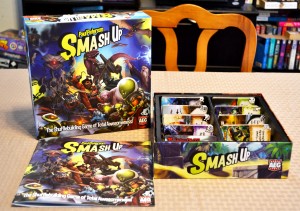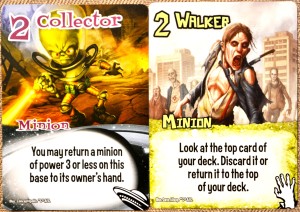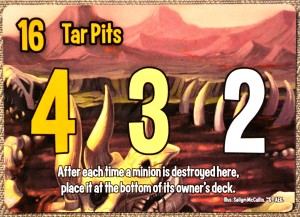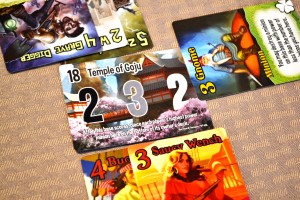Want to play as wizard dinosaurs, robot pirates, or ninja zombies? Of course you do. “Smash Up” is a card-fighting game that lets players choose two factions, combine them into one deck, and duke it out with their fellow players. While ruining someone else’s day is certainly fun to do (in the realm of gaming, of course), players will be earning points by trying to control various bases as they appear on the table. Which two factions will YOU choose? I admit, dinosaur ninjas have a certain appeal…I mean, who wouldn’t want to see dinosaurs sneaking around and doing backflips? It worked for the “Teenage Mutant Ninja Turtles”, didn’t it?
Components
Faction Cards – The game includes a total of one hundred and sixty cards, which are broken up into eight, twenty card decks. Each deck represents a particular faction.
Base Cards – These larger base cards are the locations in which players will be fighting for control. Base cards list a series of victory point values, a breakpoint value, and a special ability.
Pencil & Paper (Not Included) – You’ll need a way to track everyone’s score.
Setup & Gameplay
Each player will pick two faction decks and combine/shuffle them into one face-down draw deck. The base cards are shuffled as well, with one being dealt per player plus one onto the middle of the table (three players = four base cards, two players = three base cards, etc.). Each player draws a hand of five cards, though if no minions are in a player’s hand, they can reveal it in order to discard them and draw five more (this can only happen once). Whoever got up the earliest that morning goes first.
A player’s turn is broken up into five phases:
1) Crank It Up – Any cards that activate their abilities during this phase are observed.
2) Play Cards – A player can play one minion, perform one action, or do both. Minions are played on bases, activating their special ability when placed (as appropriate). Actions are played from a player’s hand and discarded afterwards (unless it’s an ongoing ability).
3) Check For Scoring – When a base reaches its breakpoint (when the power of the minions present equal or exceed the breakpoint value), it scores the victory points shown. Before points are awarded however, players can make use of special abilities as appropriate. After that, the first place victory point value goes to the player with the most power there, and so on. The minions present go to their respective owner’s discard pile while the base itself is discarded. A new base is drawn to replace it.
4) Draw 2 Cards – The player will draw two cards, up to a hand limit of ten. If their draw pile runs out, they’ll simply shuffle their discard pile and start anew.
5) Shut It Down – Any cards that activate their abilities during this phase are observed.
Play will continue clockwise around the table until the game ending condition is met. The first player to score fifteen victory points wins the game!
The above doesn’t cover all of the rules found in the manual, but should give you an idea as to how the game is played. For more information, you can view the manual here:
http://www.alderac.com/smashup/files/2012/06/AEG-SU-Rulebook.pdf
The Review
I have to say, I really enjoyed the art featured on the various cards. Each deck is supposed to represent a particular faction, and it certainly shows. Aliens felt like aliens, robots felt like robots, and so on. The game is fairly text heavy and requires a lot of reading, but I didn’t have too much trouble reading the cards (even with my poor eyesight). Like with most card games that feature a lot of text, there are actually two learning curves at work. The first one, learning how to play the game, is relatively easy in this case. The second one, learning how the cards interact and getting used to their abilities, takes bit longer. Some cards have ongoing abilities, so it pays to have someone in your group who has a good memory and can keep track of what all should be observed over the course of the game.
My favorite aspect of the game was how the different factions behaved. While the art was indeed thematic, the factions themselves have their own way of playing. Some factions have very powerful minions while others favor area and crowd control with unique abilities. Zombie minions, for example, are extremely durable while wizards can chain actions until the next sunrise. Before picking your two factions, it pays to quickly go through their decks to see what kind of traits they have. It won’t be long until you have a favorite or two, though it’s always fun to try different deck combinations to see how they perform. I didn’t run into any balance issues, meaning that I didn’t find one faction more powerful than another…they just played differently.
Vinnie Jr (12) really got a kick out of playing “Smash Up”. He’s heavy into card battlers like “Pokemon”, so this was right up his alley. Reading cards and remembering their effects didn’t phase him in the slightest. I myself enjoyed the experience and I surprisingly didn’t become overwhelmed with the card abilities like I tend to do in “Magic: The Gathering”. As such, I’ve deemed this to be a great family-friendly card game that would appeal to most people. The card mechanics are light enough for both casual and hardcore gamers to enjoy it, I feel. It may take time for some players to form strategies during play (chaining cards, thinking ahead, etc.), but it doesn’t get ridiculously complex. All in all, “Smash Up” is an overall excellent choice for game night.
Final Verdict: 9/10
—




